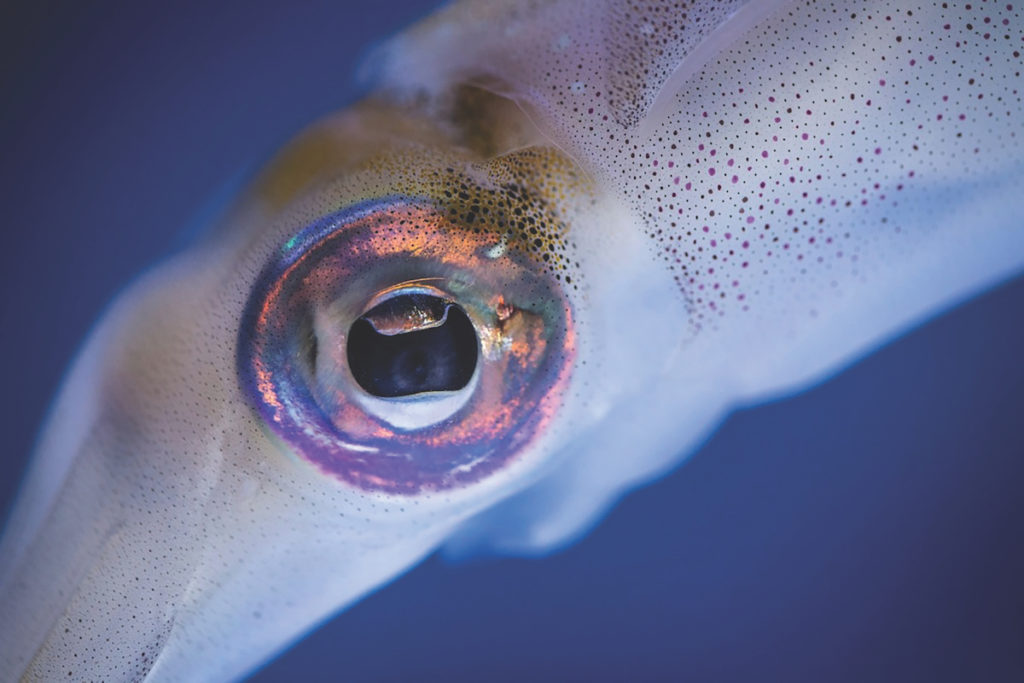
It seems fitting at the end of this year to find oneself humming “Suite: Judy Blue Eyes.”
“Don’t let the past remind us of what we are not now….”
Stephen Stills wrote that song, the one Crosby, Stills, and Nash opened with at Woodstock, to woo back his ex, the folk singer Judy Collins. It became an anthem for a generation and it still resonates today — with lessons on life, love, and, yes, even squid, if you let it.
Judy Collins and squid are about as far apart as can be on the tree of life. One has a spine strong enough to leave her rock ’n’ roll boyfriend after what we must assume were “free love” shenanigans. The other has a paper-thin piece of cartilage inside of it that eons ago was an external shell.
Yet they have remarkably similar eyes. Squid have camera-type eyes — with an iris, lens, vitreous gel, pigment cells, and photoreceptor cells that translate light from the retina into nerve signals that reach the brain. If that sounds familiar, it’s because our eyes have the same structures. It is amazing that an ancient snail-descended mollusk and human beings could evolve to have such comparable eyes.
People find octopuses fascinating, and in part that’s because of their eyes — eyes that stare back and make it seem, among other things, as if they have a soul. I’d argue that squid have similarly compelling eyes. It’s just harder to meet them.
Neuroscientists at the Gilly Lab at Stanford University’s Hopkins Marine Station explain in “Squid Brains, Eyes, and Color” that octopuses live in dens on the sea floor, an environment that is fairly easy to recreate in an aquarium. It’s harder to study squid intelligence because their natural habitat is the open ocean, where it’s just not as easy to give a squid a puzzle to solve.
We are told that the eyes are the window to the soul. But one way that squid eyes are different from humans’ is that, for squid, the window has no glass. Which is to say, a squid eye does not have a cornea. Perhaps this makes the eyeball itself more flexible under the pressure of the deep waters where squid live.
Another difference is that squid have U-shaped pupils, which allow light to enter the eye through the lens from many directions rather than just straight into the retina. That’s actually a bug that may turn out to be a feature, as we’ll see.
Like sweet Judy’s, squid eyes are all about the color blue. Only whereas Judy’s eyes are famously ice blue to the beholder, with squid it’s about what they behold.
Squid have photoreceptor cells containing only one visual pigment. That is, they are color blind, seeing only in shades of blue. For our local squid, that has been determined to be at the wavelength of 493 nanometers: blue-green.
This fact of squid color blindness does “thrill me to the marrow,” to quote the song, because it makes the squid’s mastery of camouflage especially intriguing. Squid can turn any color to match any background. They do so almost instantaneously. But how can that be if they are optically color blind?
Roger Hanlon, a noted cephalopod expert and squid guru at the Woods Hole Marine Biological Laboratory, says this question remains one of the big unanswered ones in the field. “We put two postdocs on it for a year and came up with no clear answer,” he told me.
One theory is that squid have some sort of photoreceptor-like detector in their skin. Hanlon’s group has explored that idea extensively without reaching a definitive finding.
But insights have come from outside the tiny world of teuthologists, as squid scientists are called. In July 2016, a pair of astrophysicists published a theory in the Proceedings of the National Academy of Sciences positing that squid do something like what photographers call “color fringing.” That is, they adjust the focal position of their oddly shaped pupils to collect spectral information about the objects around them. You might say they do see colors — they just see them differently.
Of course, squid live at depths in the sea where it is very dark, so they might not have had the need to see different wavelengths of light bouncing off of things at all times, as we do when we take a walk in the woods. Over the eons, then, it would make sense that squid never developed a complex array of photoreceptors. They made do with what they had.
Advice from Stephen Stills and from the squid for the New Year ahead: “You are what you are.”



